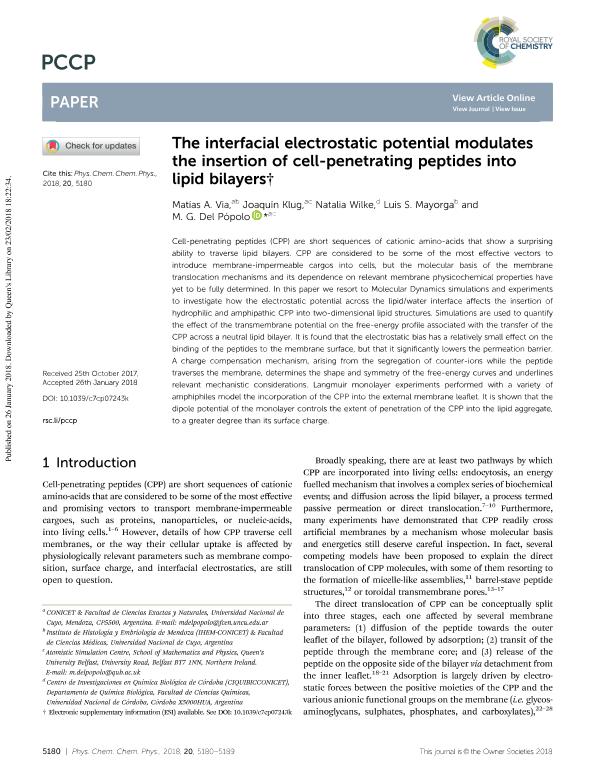Mostrar el registro sencillo del ítem
dc.contributor.author
Via, Matías Alejandro

dc.contributor.author
Klug, Joaquín

dc.contributor.author
Wilke, Natalia

dc.contributor.author
Mayorga, Luis Segundo

dc.contributor.author
del Popolo, Mario Gabriel

dc.date.available
2020-01-24T23:07:01Z
dc.date.issued
2018-06
dc.identifier.citation
Via, Matías Alejandro; Klug, Joaquín; Wilke, Natalia; Mayorga, Luis Segundo; del Popolo, Mario Gabriel; The interfacial electrostatic potential modulates the insertion of cell-penetrating peptides into lipid bilayers; Royal Society of Chemistry; Physical Chemistry Chemical Physics; 20; 7; 6-2018; 5180-5189
dc.identifier.issn
1463-9076
dc.identifier.uri
http://hdl.handle.net/11336/95823
dc.description.abstract
Cell-penetrating peptides (CPP) are short sequences of cationic amino-acids that show a surprising ability to traverse lipid bilayers. CPP are considered to be some of the most effective vectors to introduce membrane-impermeable cargos into cells, but the molecular basis of the membrane translocation mechanisms and its dependence on relevant membrane physicochemical properties have yet to be fully determined. In this paper we resort to Molecular Dynamics simulations and experiments to investigate how the electrostatic potential across the lipid/water interface affects the insertion of hydrophilic and amphipathic CPP into two-dimensional lipid structures. Simulations are used to quantify the effect of the transmembrane potential on the free-energy profile associated with the transfer of the CPP across a neutral lipid bilayer. It is found that the electrostatic bias has a relatively small effect on the binding of the peptides to the membrane surface, but that it significantly lowers the permeation barrier. A charge compensation mechanism, arising from the segregation of counter-ions while the peptide traverses the membrane, determines the shape and symmetry of the free-energy curves and underlines relevant mechanistic considerations. Langmuir monolayer experiments performed with a variety of amphiphiles model the incorporation of the CPP into the external membrane leaflet. It is shown that the dipole potential of the monolayer controls the extent of penetration of the CPP into the lipid aggregate, to a greater degree than its surface charge.
dc.format
application/pdf
dc.language.iso
eng
dc.publisher
Royal Society of Chemistry

dc.rights
info:eu-repo/semantics/openAccess
dc.rights.uri
https://creativecommons.org/licenses/by-nc-sa/2.5/ar/
dc.subject
cell-penetrating peptides
dc.subject
molecular dynamics
dc.subject
lipid bilayers
dc.subject.classification
Biología Celular, Microbiología

dc.subject.classification
Ciencias Biológicas

dc.subject.classification
CIENCIAS NATURALES Y EXACTAS

dc.title
The interfacial electrostatic potential modulates the insertion of cell-penetrating peptides into lipid bilayers
dc.type
info:eu-repo/semantics/article
dc.type
info:ar-repo/semantics/artículo
dc.type
info:eu-repo/semantics/publishedVersion
dc.date.updated
2019-10-21T20:07:14Z
dc.journal.volume
20
dc.journal.number
7
dc.journal.pagination
5180-5189
dc.journal.pais
Reino Unido

dc.journal.ciudad
Cambridge
dc.description.fil
Fil: Via, Matías Alejandro. Consejo Nacional de Investigaciones Científicas y Técnicas. Centro Científico Tecnológico Conicet - Mendoza. Instituto de Histología y Embriología de Mendoza Dr. Mario H. Burgos. Universidad Nacional de Cuyo. Facultad de Ciencias Médicas. Instituto de Histología y Embriología de Mendoza Dr. Mario H. Burgos; Argentina
dc.description.fil
Fil: Klug, Joaquín. Consejo Nacional de Investigaciones Científicas y Técnicas. Centro Científico Tecnológico Conicet - Mendoza; Argentina. Universidad Nacional de Cuyo. Facultad de Ciencias Exactas y Naturales; Argentina. The Queens University of Belfast; Irlanda
dc.description.fil
Fil: Wilke, Natalia. Consejo Nacional de Investigaciones Científicas y Técnicas. Centro Científico Tecnológico Conicet - Córdoba. Centro de Investigaciones en Química Biológica de Córdoba. Universidad Nacional de Córdoba. Facultad de Ciencias Químicas. Centro de Investigaciones en Química Biológica de Córdoba; Argentina
dc.description.fil
Fil: Mayorga, Luis Segundo. Consejo Nacional de Investigaciones Científicas y Técnicas. Centro Científico Tecnológico Conicet - Mendoza. Instituto de Histología y Embriología de Mendoza Dr. Mario H. Burgos. Universidad Nacional de Cuyo. Facultad de Ciencias Médicas. Instituto de Histología y Embriología de Mendoza Dr. Mario H. Burgos; Argentina
dc.description.fil
Fil: del Popolo, Mario Gabriel. Consejo Nacional de Investigaciones Científicas y Técnicas. Centro Científico Tecnológico Conicet - Mendoza; Argentina. Universidad Nacional de Cuyo. Facultad de Ciencias Exactas y Naturales; Argentina. The Queens University of Belfast; Irlanda
dc.journal.title
Physical Chemistry Chemical Physics

dc.relation.alternativeid
info:eu-repo/semantics/altIdentifier/url/http://xlink.rsc.org/?DOI=C7CP07243K
dc.relation.alternativeid
info:eu-repo/semantics/altIdentifier/doi/https://doi.org/10.1039/C7CP07243K
Archivos asociados
